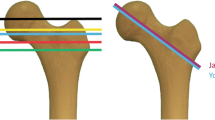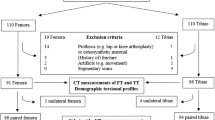Abstract
Objective. A torsional difference of more than 15° is found in up to 30% of patients following closed intramedullary nailing of femoral fractures. The diagnosis is usually established postoperatively by computed tomography. A torsional deformity of more than 15° should be corrected by early derotation. In order to enable an intraoperative control and possible correction to avoid a second operation for the patient, a new ultrasound-based method suitable for the intraoperative setting has been developed, using the anterior condylar line as a distal reference line.
Design and patients. In a prospective study the torsional difference after closed intramedullary nailing of femoral fractures was measured postoperatively by ultrasound in 32 patients and compared with standard CT readings.
Results. Torsional differences measured by ultrasound and CT showed a high correlation (r=0.8) and a median difference of less than ±3°.
Conclusions. By the introduction of the anterior condylar line as a distal reference line femoral torsion can accurately be assessed by ultrasound in a position required for intraoperative control and possible correction.
Similar content being viewed by others
Author information
Authors and Affiliations
Additional information
Received: 8 January 1999 Accepted: 2 March 1999
Rights and permissions
About this article
Cite this article
Ehrenstein, T., Rikli, D., Peine, R. et al. A new ultrasound-based method for the assessment of torsional differences following closed intramedullary nailing of femoral fractures. Skeletal Radiol 28, 336–341 (1999). https://doi.org/10.1007/s002560050527
Issue Date:
DOI: https://doi.org/10.1007/s002560050527




